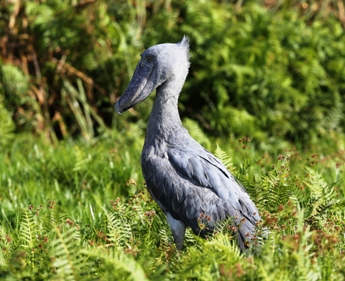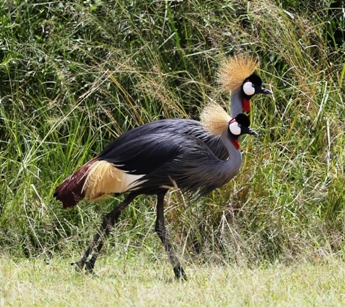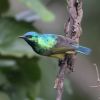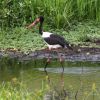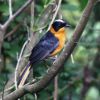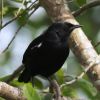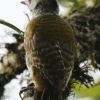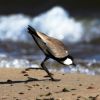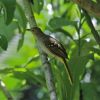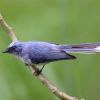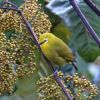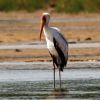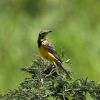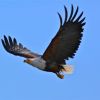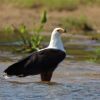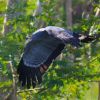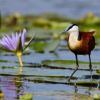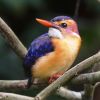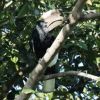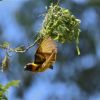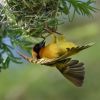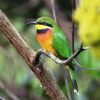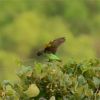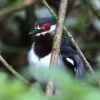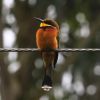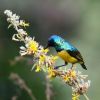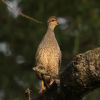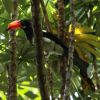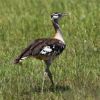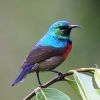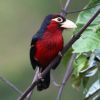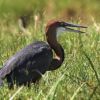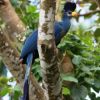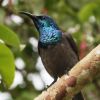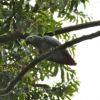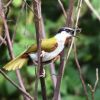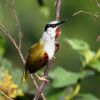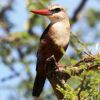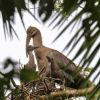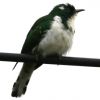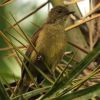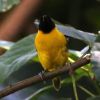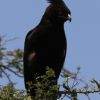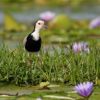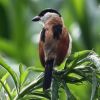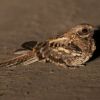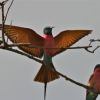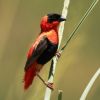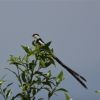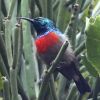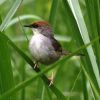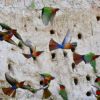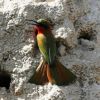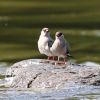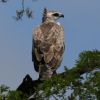Day1
Depending on your flight arrival we can either start with a visit of the Entebbe Botanical Garden, which offers a good introduction for not just the plants, but also the birdlife of Uganda as well. If we have more time we can travel to a nearby marsh today, otherwise we start tomorrow with that programme. At the outskirts of Kampala and even in the city Marabou Stork is common and of course Hooded Vultures and Yellow-billed Kites are omnipresent.
Day2
Today we start with a travel to a huge marsh alongside Lake Victoria where we use a small boat and local guide to search one of the most iconic birds of Uganda, the prehistoric-looking Shoebill. Although it is a huge bird and the area boasts of several pairs it is not granted that we find it, especially so easily as on our last tour, within 20 minutes! Beside this enigmatic bird we will try to find other local specialities such as Papyrus Gonolek, African Pygmy Goose or Swamp Flycatcher. Blue-breasted Bee-eaters should be around, while Pied and Malachite Kingfishers will be in good numbers. Beside African Jacanas we will look for Lesser Jacana, Long-toed Plover and Purple Swamphen as well. Sky will be ruled by African Marsh Harrier and African Fish Eagle. We should also see a number of egrets, herons, storks, terns and waterfowl as well.
Please note that timing of this programme will depend on your arrival and departure times, so we might do it on the first day or on the last.
Later we head to North towards the Murchison Falls National Park. It is a long drive, but plenty of birds to see on the way, especially raptors like Lizard Buzzard, African Harrier-Hawk, Black-winged Kite, the funny-looking Long-crested Eagle and perhaps even a fish-eater Palm-nut Vulture or a soaring Wahlberg’s Eagle. There is also a good chance to pinpoint some of the larger birds even during driving, such as the strange Black-and-white-casqued Hornbills, African Pied and Crowned Hornbills, a loud Eastern Plantain-eater or a beautiful Great Blue Turaco. But we also plan a couple of short brakes on the way to enjoy habitats and scenery and try to find some more birds such as Splendid and Rüppell’s Starlings, Piapiac, European Hoopoe, Fork-tailed Drongo, Common Bulbul, Woodland Kingfisher, Broad-billed Roller, Angola Swallow, African Thrush, Pintailed Whydah, Grey-backed Fiscal, Northern Black Flycatcher, Sooty Chat, Scarlet-chested & Beautiful Sunbird.
In the late afternoon before dusk we arrive to our accommodation close to the Murchison Falls National Park.
Day3
We have a full day long birding & mammal safari in the National Park. This is the largest National Park in Uganda with about 4000 square km area, having several amazingly good spots for wildlife. This was also the only NP where you could have all the “big five”, but sadly by now rhino is extirpated by poachers. There are almost always different mammals around ranging from Common Warthog, Waterbuck, Bushbuck, Uganda Kob, Hartebeast through Buffalos, Giraffes, Hippos till African Elephants, but even Lions we might see. On the other hand in terms of birds the list is almost 500 species long; just raptors represented by more than 50 species, including Secretary Bird, Martial and African Crowned Eagle.
It will be not easy to decide on which area we should concentrate. On the Northern part wet and dry savannas alternate. This is the area where close to each other it is possible to see so various species such as the archaic-looking Abyssinian Ground Hornbill, African Quail-finch, Black-billed Barbet, Yellow-fronted Tinkerbird, Black-headed Plover, Denham's Bustard, Piapiac, amazing Swallow-tailed & Red-throated Bee-eater, Silverbird, Speckle-fronted Weaver, Swamp Flycatcher, White-browed & Chestnut-crowned Sparrow-weaver, Eastern grey Plantain-eater, just to mention a few. We also have a good chance for Uganda’s national bird, Grey-crowned Crane here and even Shoebill. Kingfishers and Herons will be represented by several species, including the largest ones, Giant Kingfisher and Goliath Heron as well. This is also a good area for Heuglin’s Francolin, Spotted and Senegal Thick-knee. Other possible species include Black-billed Wood-Dove, Vinaceous Dove, Vitelline Masked Weaver, Bar-breasted Firefinch, Whistling Cisticola. There is an outside chance for the very localized White-fronted Black Chat, Red-winged Grey Warbler and White-rumped Seedeater. It is always worth to check the top of the cliffs peaking out from the River Nile for Rock Pratincoles.During the evening Long Tailed-, Standard-winged and Pennant-winged Nightjars are possible.
Day4
Before we say goodbye to Murchison Falls National Park we have a final birding in the morning at the Southern part in the Budango Forest at the famous Royal Mile section. The forest is the second most important in Uganda - after Semliki National Park where we will head later during the day - for species of the Guinea-Congo forest Biome. The Royal Mile is a superb birding area with many West- & Central African species, as well as a variety of other sought-after key species, such as as two species, Yellow-footed Flycatcher and Puvel's Illadopsis which can be found just in Budango Forest in whole East Africa!
Other key species that can be found here include Nahan's Francolin, elusive White-spotted Flufftail, Sabine's Spinetail, very localized Cassin's Spinetail, Blue-breasted Kingfisher, spectacular Chocolate-backed Kingfisher, African Dwarf Kingfisher, uncommon Blue-throated Roller, Black Scimitarbill, very localized Piping & White-thighed Hornbill, Hairy-breasted Barbet, Yellow-spotted Barbet, Yellow-billed Barbet, Brown-eared Woodpecker, Yellow-crested Woodpecker, Spotted Greenbul, Fire-crested Alethe, Blue-shouldered Robin-Chat, Red-capped Robin-Chat, Lemon-bellied Crombec, Rufous-crowned Elemomela, Yellow-browed Camaroptera, Black-capped Apalis, Ituri Batis, Chestnut-caped Flycatcher, Grey-headed Sunbird and Western-black Headed Oriole
Finally we travel towards the Semliki Forest first through the busy Masindi and Hoima towns on a road parallel with the Albertine Rift Valley, later during the afternoon we stop at a roadside dense forest to break the journey before we reach the Northern foot of the mighty, snow-capped Rwenzori Mountains, close to the Semliki Forest.
Day5
Full day long birding at Semliki Forest. This is a unique area, the best large lowland rainforest patch which offers one of the best sites for forest birding in Africa. There is a good chance to add several species associated to the Congolese rainforest. This more than 200 square km area boasts of close to 500 bird species including nine different species of hornbill, some can not be found anywhere else in Uganda or further East, such as Red-billed Dwarf-, Black Dwarf-, White-crested- & Black-casqued Wattled Hornbill. There are another more than 30 species of Albertine Rift Valley endemics possible here. The combination of lowland tropical rainforest birding and the visit of marshy areas alongside Lake Albert offers a wide variety of different birds such as Long-tailed Hawk, Western Bronze-naped Pigeon, Yellow-throated Cuckoo, Black-throated Coucal, scarce Red-rumped Tinkerbird, Lyre-tailed Honey Guide, African Piculet, Gabon Woodpecker, Rufous-sided Broadbill, Yellow-throated Nicator, Icterine Greenbul, Xavier's Greenbul, At the marshy area we look for Spot-breasted Ibis, Nkulengu Rail, White-bellied Kingfisher, Swamp palm Bulbul. Night close to the Semliki forest.
Day6
We start with a half day final birding in the Semliki area which gives us a chance to find some of the below species: Leaf-love, Green-tailed Bristlebill, Fire-crested Alethe, Northern Bearded Scrub Robin, Blue-headed Crested-flycatcher, Maxwell's Black Weaver, Blue-billed-, Crested & Red-bellied Malimbe, Chestnut-breasted Negrofinch, Grant's Bluebill and Orange-Cheeked Waxbill.
After lunch at Fort Portal area we travel to Kibale/Bigodi area where we spend the afternoon with birding alongside the dirt-road passing through the Kibale forest. Beside Red-chested Cuckoo we might find Dusky long-tailed Cuckoo, Yellow-fronted Tinkerbird, Forest Robin and Scale-breasted Illadopsis. Sometimes even without entering the dense forest we can spot Red-tailed Monkey or Grey-cheeked Mangabey.
During the evening we should hear and spot African Wood Owl, but a number of other interesting species are possible as well. Night at Kibale/Bigodi area
Day7
After early morning birding we either start with half day chimps track (optional programme, not included in the price) or birding in the forest. It is just an incredible feeling to stare in the eyes of an adult chimpanzee in the dense forest. Beside chimpanzees there is a good chance to see other various species of other primates as well, such as Grey-cheecked Mangabey, L’Hoest’s Monkey or Central African Red Colobus since the park has the highest density of primates in whole East Africa! In 2013 we had seen all the above just one morning!
During birding some of the best species might include the amazing Green-breasted and African Pitta, Abyssinian Ground-thrush, the mighty African Crowned Eagle, Dusky Crimsonwing, Black-capped & Collared Apalis. Other sought-after species in the area which we look for is Purple-breasted Sunbird, Black Bee-eater, Yellow-spotted/Western Nicator, Little Greenbul, Black-eared Ground-thrush, Brown-chested Alethe, Yellow-rumped Tinkerbird and Blue-breasted Kingfisher just to mention a few.
Later on we return to our accommodation to refresh ourselves and have some lunch. In the afternoon we go on a nice loop trail with some boardwalks at a marshy area where we have a good chance to see a number of new species such as Western Nicator, Black & White Shrike-flycatcher, Green-headed & Olive-bellied Sunbird, African Green Pigeon, Grey-headed Sparrow, Common Bulbul, Hadada Ibis, Splendid Starling, Red-faced Cisticola, Brown-throated Wattle-eye and Red-headed Malimbe. With some luck we can find local specialities like Toro Olive Greenbul or Little Greenbul as well and at least we should hear White-spotted Flufftail, but it is hard to get a good view of it. We had seen on previous tours Speckled and Scaly Tinkerbird, White-throated Bee-eater, Black & White Manikin, Groesbeak Weaver, Grey-backed Camaroptera, Great Blue Turaco, Red-eyed Dove, White-chinned Prinia, Black-necked and Compact Weaver as well. Speckled-breasted Woodpecker is a good local species. Other species we noted during the walk were Woodland Kingfisher, Wholly-necked Stork, Ashy Flycatcher, Black Weaver, Collared Sunbird, Marsh Tchagra, Crested Francolin, Fan-tailed Widowbird, Grey-capped Warbler and Tambourine Dove. If we are lucky we can get Shining-blue Kingfisher as well. Finally we return to our nearby accommodation and after dinner listen of the night sounds of the forest. Night at Kibale/Bigodi area
Day8
After leaving the Kibale National Park through the forest road we travel on small roads first passing some crater lakes and then hit asphalt road on which we drive alongside the Queen Elizabeth National Park driving through Hima and Kasese towns. After crossing the Equator we can stop at a viewpoint form where we can admire the scenery with the Kazinga Channel connecting Lake George and Lake Edward. Grey-headed Sparrow, Yellow-throated Longclaw and different Canaries usually around. Sometimes thirsty Elephants come down to the water as well. When we cross the Kazinga Channel on the Katunguru Bridge we stop to check a papyrus swamp and surrounding area forPapyrus Gonolek, Lesser & Greater Swamp Warbler, Carruther’s Cisticola, White-winged Warbler. Pink-backed Pelican can be around as well, plus there are always some kingfishers like Pied & Malachite and Terns such as White-winged & Gull-billed.
Later with several birding stops we drive through Queen Elizabeth National Park, most of it through open savannas. African Marsh Harriers, various Snake-Eagles, African Harrier Hawks, Black-shouldered Kite and different species of Vultures rule the sky, including Palm-nut, Hooded , African White-backed, Ruppell’s Griffon and even Lappet-faced Vulture. Whereever we see some activity we stop to check it and we should find Green Woodhoopoe, White-browed Coucal, Black-headed Gonolek, Clapping Lark, Sooty Chat, Black-lored Babbler, Brown-crowned Tchagra, Crowned Hornbill, Red-necked Spurfowl.
Arrive late afternoon, evening to Kigezi area at Bwindi Impenetrable Forest. Night at Kigezi/Bwindi area
Day9
We start the day with a pre-breakfast birding at or around our accommodation which can produce a number of species. Beside the common ones such as Common Bulbul, African Thrush, Speckled Mousebird, Red-billed Firefinch, Streaky Seedeater, Yellow White-eye we should find plenty of other good birds as well, like Brown-throated Wattle-eye, African Pygmy Kingfisher, Crowned Hornbill, Grey-capped Warbler, Snowy-headed Robin-chat, African Blue-flycatcher. Incredible variety of Sunbirds visit the flowery bushes and trees such as Variable Sunbird albiventris race, Red-chested & Purple-breasted Sunbird, Green-headed & even Blue-headed Sunbird, Bronze Sunbird, Collared Sunbird, Copper Sunbird.
After breakfast you can continue the day either with optional Mountain Gorilla tracking in the Bwindi Impenetrable Forest or birding in the area. The Mountain Gorilla tracking is an unforgettable experience, the search itself is exciting, but to see these incredible apes up close and witness how they feed and move around it is just hard to describe. It is surely one of the ultimate wildlife experiences one can imagine!
But those who choose birding will not be bored either. The number of bird species exceeds 300 and among them there are about 2 dozens of Albertine Rift Valley endemics. Birding is not easy here, but there are so many interesting species to find, including Handsome Francolin, Olive Long-tailed Cuckoo, Abyssinian/Kivu Ground Thrush,Bar-tailed Trogon, the stunning Black Bee-eater, Archer's & White-bellied Robin-Chat, Western Green Tinkerbird, Willcocks’s and Dwarf Honeyguide. We will check the tree-trunks and branches for Elliot’s and Tullberg’s/Fine-banded Woodpeckers, while in the understorey vegetation we should look for Black-faced Prinia, African Green Broadbill, Black-faced Rufous Warbler. Apalis warblers represented by Mountain Masked, Chestnut-throated & Collared Apalis. Other Warblers to find include Mountain Yellow-, Grauer's Rush, Red-faced Woodland-, Short tailed & Grauer's Warbler and with great luck we might pinpoint the strange Neumann’s Warbler. Other big, hard-to-find rarities are the recently described Willard’s Sooty Boubou and Jameson’s Antpecker. Several localized Greenbul species include Shelley's -, Yellow-streaked-, Cabanis’s, Kakamega and Ansorge’s Greenbuls. Various Flycatchers hunting for insects include Sooty, Yellow-eyed Black, Chapin's, White-bellied Crested & White-eyed Slaty Flycatcher. Couple of forest starlings possible as well such as Waller’s, Stuhlmann’s and Narrow-tailed Starling. Without wanting to make a too long list we should mention Equatorial Akalat, the uncommon Grey-chested Babbler, White-browed Crombec, Grey Cuckoo-shrike, Red-throated Alethe, Rwenzori Batis, Dusky & Strip-breasted Tit, Tit Hylia, Northern Double-collared & Regal Sunbird, Lagden's & Doherty's Bush Shrike, Montane Oriole, Black-billed,Strange & Brown-capped Weaver, Red-fronted Antpecker, Dusky Twinspot, Dusky & Shelley's Crimsonwing, Magpie Mannikin as other possibilities. High at the canopy or just above it we should look for African Goshawk and Scarce Swifts. After an amazing day we have another night in the area. We might try to find African Wood Owl and Rwenzori Nightjar at dusk.
Day10
We say goodbye to this great place with a final birding in the morning and then we start our travel to Lake Mburo & Kigarama Hills National Park. First we drive through again the Southern part of the Queen Elizabeth NP and we leave through the Kigezi Game Reserve. Again, we will stop regularly and try to find new birds and mammals beside the ones which were mentioned or missed during previously days.
We surely will not miss Yellow Bishop, Red-collared Widowbird, Yellow-breasted Longclaw, Hammerkop, Pin-tailed Wydah, Black-headed Gonolek, European and White-throated Bee-eaters, Ruppel’s Starling and some other common species. Raptors will include African Fish Eagle, Western Banded Snake-Eagle, Bateleur, Long-crested Eagle, White-backed Vulture & African Harrier Hawk, just to mention a few. At wet areas we should find African Spoonbill, Sacred Ibis, Yellow-billed, Abdim’s & Saddle-billed Storks. Usually we see on this road African Elephants, Topi Antelopes, Buffalo, Kudu and sometimes a family of Mongoose.
Reaching the main road in the afternoon we travel from West to East crossing Bushenyi and Mbarara towns and end of the day will find us at Lake Mburo National Park. We should see a number of attractive mammal species just before and right after entering the park, such as Impalas, Zebras, Waterbucks, Bushbucks & Common Warthogs. Special birds to look for include Ross’s Turaco and African Grey Parrot. The area is also a Roller paradise, so we should find Broad-billed & Lilac-breasted before we reach our accommodation. During the night we might hear the nearby Spotted Hyenas.
Day11
After breakfast we leave our accommodation and check different parts of the National Park with a mammal and birding safari. Lake Mburo National Park is the only place in Uganda with Zebras and also where you can see regularly the huge, but shy Elan. In 2013 we bumped into a herd consisting more than 100 individuals!
Alongside the Lake Mburo in the papyrus swamps there are 6 resident endemic bird species including the Blue-headed Coucal and the amazing Papyrus Gonolek. Brown-chested Plover, Carruther's Cisticola, Pie & Blue-breasted Kingfisher, Hamerkop, Greater Painted Snipe, Open-billed Stork, White-winged Warbler, Papyrus yellow Warbler, African Finfoot and even Shoebill all live here. A big and noisy group of Black-headed and Lesser Masked Weavers nesting just at the lakeshore restaurant.
At the foothills of the Kigarama Hills among the Acacia trees and scrub we look for Crested Francolin, Abyssinian Ground Hornbill, Spot-flanked Barbet, White-browed Coucal, Bare-faced Go-away Bird and Tabora/Long-tailed Cisticola. Black-collared Barbet and Southern Ground Hornbill are species which can’t be found further North. If we have not visited Mabamba Swamp or have not seen later during the tour Shoebill then we can fit in a visit this afternoon before we travel back to Entebbe airport. Late evening departure and overnight flight.
Day12
Arrive home


























